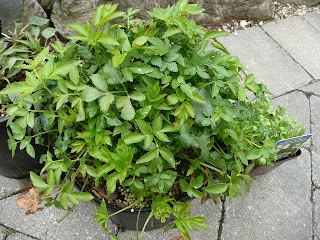 Springtime through Botanical Prints
Springtime through Botanical PrintsMarch is roaring like a lion outdoors so I am trying to bring spring indoors by visiting one of my favorite websites
Panteek prints. I am crazy about all types of prints particularly those that advance my understanding of garden history and culture. I've posted a very narrow selection of botanicals printed between 1825 and 1904. All are available for sale at Panteek but my budget allows for browsing only! The Primula above was drawn by Jane Loudon (1807-1858) in
The Ladies Flower Garden of Ornamental Perennials in 1843-9. The prints in her books were hand colored by various technicians and thus vary in quality. This one is lovely.

Benjamin Maund
The Botanical Garden 1825-1851 (above)
The Panteek write-up states that Benjamin Maund in his 13 volumes of this periodical, wanted "in the spirit so very true to the era, was to to create a work combining accurate scientific instruction with an occasional appeal to the imagination and to the moral and religious feelings". A Primula verticillata is depicted in the lower left-hand corner of the plate. Primula verticillata was introduced in England in 1825 but was collected in Yemen. An improved variety was first seen in Kew's collection in 1873 as Primula verticillata var. sinensis. It is nick-named the Abyssinian primrose.
 Gardener's Magazine of Botany
Gardener's Magazine of Botany 1850: Primula Auricula
Thomas Moore, curator of the Botanic Garden of Chelsea published
The Gardener's Magazine for a few years in the 1850's Panteek states that the earlier publications of Moore's magazine contained quality prints of "a singular beauty and grace". Jane Loudon writes in her volume
Ladies Companion to the Flower Garden that the p. auricula : is a native of the Alps of Switzerland, where its flowers are commonly yellow and very fragrant; it may be found in abundance on the roadside of the highest part of the pass of the Simplon, growing with the different Saxifrages, and not far from Rhododendron hirsutum."

Jeannie Foord Parrot Tulip 1904
I am unfamiliar with the printing process called "pochoir". Panteek writes that pochoir process involves "single layers of color ... added by hand to a lithograph using a stencil, in a precursor of the silk screening technique". Here, Foords drawings were transformed into prints by E. Greningaire of Paris. Not much is known about Foord, a Scottish artist. Panteek writes that Foord intended her drawings to be teaching templates for students of the Arts and Crafts movement.

Snowdrops circa 1896
Drawn by M. P. Vemeuil and published by Eugene Gresset, this print represents the genre of Art Nouveau French pochoir prints. I love the evolving interpretation of nature represented in these last two images. They've moved beyond attempts to realistically represent nature to the interpretation of nature in art.
I recommend a visit to
Panteek when gardening outside is unpleasant! You'll have a wonderful visit.

 Aren't bleeding hearts the most amazing construction? The dwarf deutzia next to it is also a stunner in bloom. Next week for that one maybe.
Aren't bleeding hearts the most amazing construction? The dwarf deutzia next to it is also a stunner in bloom. Next week for that one maybe. I love the colors of new spring growth on the spireas.
I love the colors of new spring growth on the spireas.








































